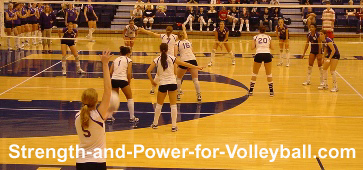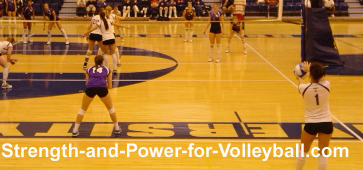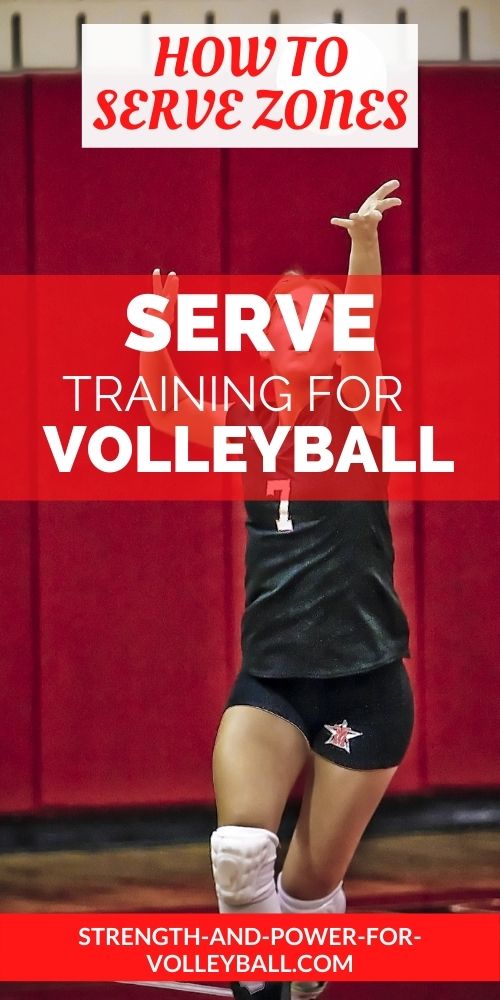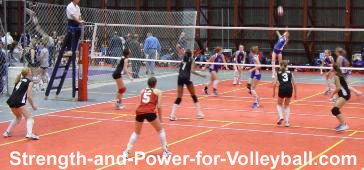Serving a Volleyball
Float Serves and Jump Serves
When it comes to serving a volleyball, every player should have skills for effective serving. The following serving techniques are for a right handed server. Use opposite feet and hand positions for serving left handed.
Serving a Volleyball Floaters
A float serve is serving the ball in a way that makes it move so that it is harder to tell where its going.
The ball is harder to track and
passers must focus harder to volleyball pass the ball.
Typical characteristics of a float serve are...
- Server contacting the ball in a way that the ball doesn't spin.
- The ball floats in the air (similar to a knuckle ball in baseball) which makes it harder to tell were the ball is headed.
Basic Mechanics of Serving a Volleyball
A float serve may be effective because...
- Passers may become lazy and lose focus on passing well.
- If passers aren't used to seeing floaters they may not have developed the volleyball skills they need to pass them.
-
Since passing floaters takes more concentration, having a good floater
can be effective against players that become tired and worn out from
long matches.
Basic mechanics of the float serve...
- Left foot in front with the feet turned slightly to the right
- Draw your arm up and back
- Take a small step as you toss the ball
- Contact the center of the ball with your palm
- Drag your back foot while serving
The basic volleyball skills of serving...
- Stand with your upper body facing the direction you are going to serve.
- Toss the ball out of your left hand and take a step with your left foot as you contact the ball.
Contacting the ball for Serving a Volleyball
You want to contact the ball in a way that makes it not spin for it to have a chance of floating. However, just because the ball doesn't spin doesn't mean that the ball will float.
By contacting the ball when it's not moving in the air (rising up or coming down) is when you have the best chance of making a firm contact to make the ball float.
So, after tossing, make contact with the ball at its highest point, hitting the ball firmly with the palm of the hand.
Contacting the ball so that it doesn't have spin as it travels over the net also allows it to get there sooner.
This makes it more difficult to pass because your opposition has less time to react to pass the ball.
The toss
Obviously, hitting the ball at its
highest point will be influenced by your toss, and your toss is highly
influenced by your armswing.
When thinking of volleyball skills for the serve, an important skill often overlooked is the toss. Consistent serving may be easier to develop because of good tosses.
Drag the back foot
Drag your back foot by sliding your toes on
the ground as you're serving. Dragging it allows you to keep your body
in the right position during the serve.
If you enjoyed these tips and would like to keep it close to you at any time, just save this pin to your Pinterest Volleyball Training Board.
Jump Serving a Volleyball
Many jump serves are successful just because players aren't used to passing a serve with topspin. A ball served topspin may drop quickly and if players aren't paying attention, they are caught off guard and aren't ready to move forward to pass the ball.
On the other hand, jump serves can be easier to pass than floaters. The ball typically comes in more of straight line to passers and players can develop confidence passing topspin serves that come right to them.
Basic mechanics of the jump serve...
- Stand with the appropriate distance behind the endline.
- Hold and toss the ball with the hitting hand.
- Take a three step approach.
- Contact the ball at your jumps highest point.
Serving a Volleyball to Zones
Serving spots may be the easiest and most effective way to serve passers that have good passing skills.
Volleyball skills for spot serving
Sometimes it can be
difficult getting floaters to go where you want them to. Often it is
easier and more effective to serve particular spots on the court without
floating.
Spot serves are different from float serves in that it isn't as important to get the ball to float. You can make it difficult for the other team just by making them move and pass a ball from a spot they don't want to.
You will have a big advantage serving if you can serve the ball wherever you want. There may not be an easier way to frustrate good setters than to make them run around the court chasing bad passes.
Knowing your opponents strengths and weaknesses and offensive strategy will help the execution of effective serving.
Serving a Volleyball Related Pages
Serve TermsVolleyball › Volleyball Techniques › Serving a Volleyball



